
The Great Pyramid of Giza is the largest Egyptian pyramid. It served as the tomb of pharaoh Khufu, who ruled during the Fourth Dynasty of the Old Kingdom. Built c. 2600 BC, over a period of about 27 years, the pyramid is the oldest of the Seven Wonders of the Ancient World, and the only wonder that has remained largely intact. It is the most famous monument of the Giza pyramid complex, which is part of the UNESCO World Heritage Site "Memphis and its Necropolis". It is situated at the northeastern end of the line of the three main pyramids at Giza.
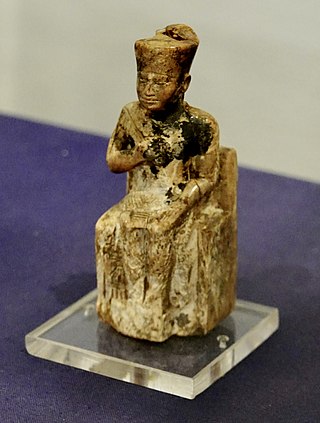
Khufu or Cheops was an ancient Egyptian monarch who was the second pharaoh of the Fourth Dynasty, in the first half of the Old Kingdom period. Khufu succeeded his father Sneferu as king. He is generally accepted as having commissioned the Great Pyramid of Giza, one of the Seven Wonders of the Ancient World, but many other aspects of his reign are poorly documented.

The Egyptian pyramids are ancient masonry structures located in Egypt. Sources cite at least 118 identified "Egyptian" pyramids. Approximately 80 pyramids were built within the Kingdom of Kush, now located in the modern country of Sudan. Of those located in modern Egypt, most were built as tombs for the country's pharaohs and their consorts during the Old and Middle Kingdom periods.

The Fourth Dynasty of ancient Egypt is characterized as a "golden age" of the Old Kingdom of Egypt. Dynasty IV lasted from c. 2613 to 2494 BC. It was a time of peace and prosperity as well as one during which trade with other countries is documented.

The Giza pyramid complex in Egypt is home to the Great Pyramid, the Pyramid of Khafre, and the Pyramid of Menkaure, along with their associated pyramid complexes and the Great Sphinx. All were built during the Fourth Dynasty of the Old Kingdom of ancient Egypt, between c. 2600 – c. 2500 BC. The site also includes several temples, cemeteries, and the remains of a workers' village.

Abusir is the name given to an ancient Egyptian archaeological pyramid complex comprising the ruins of 4 kings' pyramids dating to the Old Kingdom period, and is part of the Pyramid Fields of the Memphis and its Necropolis UNESCO World Heritage Site.
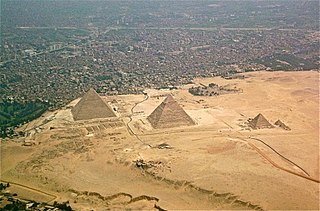
The Giza Plateau is a limestone plateau in Giza, Egypt, the site of the Fourth Dynasty Giza pyramid complex, which includes the pyramids of Khufu, Khafre and Menkaure, the Great Sphinx, several cemeteries, a workers' village and an industrial complex. It forms the northernmost part of the 16,000 ha Pyramid Fields in the Western Desert edge of the Nile Valley that are part of the UNESCO World Heritage Site, Memphis and its Necropolis.

The Khufu ship is an intact full-size solar barque from ancient Egypt. It was sealed into a pit alongside the Great Pyramid of pharaoh Khufu around 2500 BC, during the Fourth Dynasty of the ancient Egyptian Old Kingdom. Like other buried Ancient Egyptian ships, it was part of the extensive grave goods intended for use in the afterlife. The Khufu ship is one of the oldest, largest, best preserved vessels from antiquity. It is 43.4 metres (142 ft) long, 5.9 metres (19 ft) wide, and 1.78 meters deep, and is the world's oldest intact ship. It has been described as "a masterpiece of woodcraft" that could sail today if put into a lake or a river.
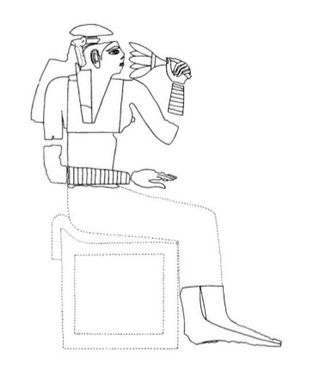
Hetepheres I was a queen of Egypt during the Fourth Dynasty of Egypt who was a wife of one king, the mother of the next king, the grandmother of two more kings, and the figure who tied together two dynasties.
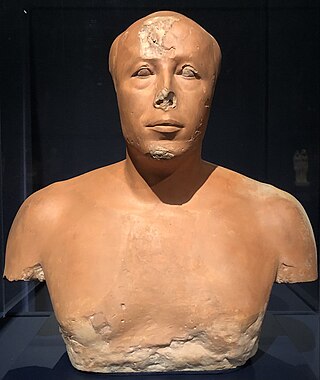
Ankhhaf was an Egyptian prince and served as an overseer during the reign of the Pharaoh Khufu, who is thought to have been Ankhhaf's half-brother. One of Ankhaf's titles is also as a vizier, but it is unknown under which pharaoh he would have held this title. He lived during Egypt's 4th Dynasty.
Meritites I was an ancient Egyptian queen of the 4th Dynasty. Her name means "Beloved of her Father". Several of her titles are known from a stela found at Giza. She was buried in the middle Queen’s Pyramid in Giza.

Henutsen is the name of an ancient Egyptian queen consort who lived during the 4th dynasty of the Old Kingdom Period. She was the second or third wife of pharaoh Khufu and most possibly buried at Giza.
Khufukhaf I was an ancient Egyptian prince and vizier of the 4th Dynasty.
Nefertkau II was an Ancient Egyptian noble lady, the wife of Prince Khufukhaf I, son of pharaoh Khufu.

The East Field is located to the east of the Great Pyramid of Giza and contains cemetery G 7000. This cemetery was a burial place for some of the family members of Khufu. The cemetery also includes mastabas from tenants and priests of the pyramids dated to the 5th and 6th Dynasty.

G1-a is one of the subsidiary pyramids of the Giza East Field of the Giza Necropolis, located immediately to the eastern side of the Great Pyramid of Giza. It was built during the Fourth Dynasty of Egypt. The tomb is the northernmost of the three pyramids of the queens.
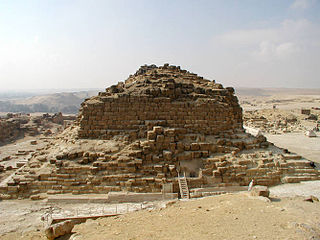
G1-b is one of the subsidiary pyramids of the Giza East Field of the Giza Necropolis immediately to the eastern side of the Great Pyramid of Giza, built during the Fourth Dynasty of Egypt. It is the central of the three pyramids of the queens, located ten meters south of the Pyramid G1-a. It has a base of 50 meters and had an original height of 30 meters. Egyptologists Mark Lehner and Rainer Stadelmann attribute it to the queen Meritites I. Zahi Hawass, however, attributes it to Queen Noubet, who gave birth to Djedefre. It is one of the queen pyramids near Pyramid Khufu along with the other two queen pyramids Pyramid G1-a and Pyramid G1-c, along with another smaller pyramid called Pyramid G1-d.

Pyramid G1-d is a satellite pyramid within the Khufu pyramid complex on the Giza plateau.

The Inventory Stela is an ancient Egyptian commemorative tablet dating to the 26th Dynasty. It was found in Giza during the 19th century. The stela presents a list of 22 divine statues owned by a Temple of Isis, and goes on to claim that the temple existed since before the time of Khufu.

The tomb of Hetepheres I is an Ancient Egyptian shaft tomb at Giza. It is part of the Eastern Cemetery of the Great Pyramid of Giza and is located near the northeast corner of the northern pyramid of Queen G I-a. The Egyptian queen Hetepheres I was the mother of Khufu and probably the wife of Sneferu.


















